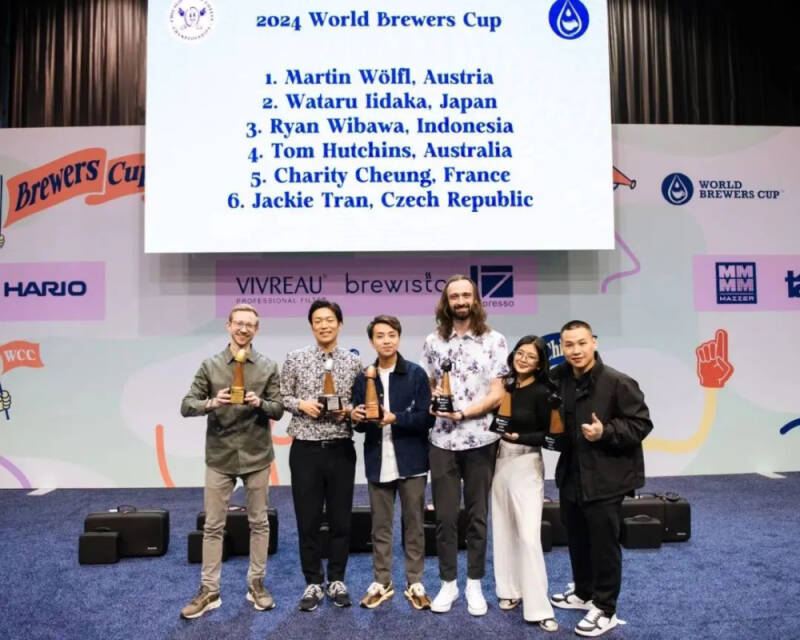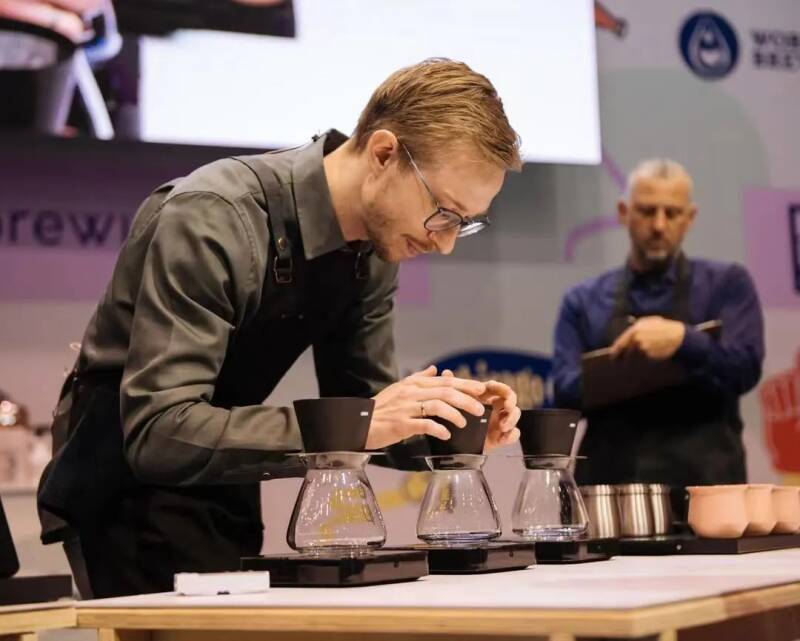Blending coffee beans has become the latest trend in the world's brewing competition
▲
Click follow | Daily boutique coffee culture magazine coffee workshop
In recent days, the eye-catching 2024 World Coffee Brewing Competition WBrC (World Brewers Cup) and World Cup Test Competition (WCTC) have been staged in Chicago, USA. Although there is a full 13-clock jet lag between China and the country, enthusiasts still set the alarm clock, squat in front of the screen waiting for the long-awaited player to enter the stage, and even carefully write down every appliance, beans and parameters they use in order to turn the disc later.

With the splendid competition of the contestants, finally in the early morning of the 15th, around 4: 00 Beijing time, the result of this WBrC competition was officially announced. The championship trophy was won by Martin Wolf from Austria. Japan's Wataru Iidaka and Indonesia's Ryan Wibawa won the second and third places respectively, which is really gratifying.
Friends who are familiar with the rules of the world coffee competition should know that WBrC is divided into two parts, designated brewing and optional brewing. Among them, the designated brewing module will be designated by the organizer to specify a coffee bean. Without knowing the specific parameters, all contestants need to analyze and come up with a set of brewing plan for production and display within half an hour. Therefore, it is a great test of the contestants' professional skills and adaptability.

As for the optional part, baristas can independently decide to cook beans, and specially develop a corresponding unique cooking plan, so the optional module on the final court every year is also the most eye-catching moment. In order to show their skills in flavor, the contestants usually contact the manor in advance to select the desired one from a group of excellent quality coffee beans, and sometimes adopt innovative and exquisite post-processing methods to win the "favor" of the judges in all directions.
It is worth noting that among the six finalists in this year's final, except for champion Martin and Czech player Jackie Tran, who ranked sixth, four contestants from second to fifth all chose to mix coffee. A series of double spelling and triple spelling are dizzying, and the ideas on various spellings are also very interesting. Some people use American beans to match Asian beans, some people use different treatments to superimpose to create a compound flavor type, and some contestants use "Rose Summer" and "Big belly navel" to play bean seed matching, while others only love Panama Rose Summer.
For example, the contestant Wataru Iidaka from Japan carefully selected the rose summer coffee beans from three well-known estates in Panama and poured them into a filter cup layer by layer, namely, 6 grams of Jensen manor roses to provide acidity, 5 grams of Jensen manor roses to highlight the sweetness of candy, and finally, 4 grams of jadeite manor honey to treat rose summer to gather the fragrance of flowers. The three-in-one of the summer of Panama, I asked you if you were convinced.
Another barista from France, Charity Cheung, borrowed from the French champagne region, combining beans from three different places and treatments to extract, including 30% roses from Abu Manor Panama, 10% Eugene, 60% Chateau Mikawa, giving the coffee a richer taste.
It is reported that in addition to the several baristas in the final, more than half of the more than 40 contestants in the World Cooking Competition have adopted the matching mode. It is believed that blended beans have more aromatic compounds than single coffee, which can provide more complex flavor types for brewing, proper selection of its characteristics can also play a 1: 1 > 2 effect, and it is easier to pursue the balanced performance of extraction.
Thus it can be seen that the development direction of the current boutique coffee trend is no longer satisfied with the flavor transmission of a single origin, or simply emphasizes the rarity of origin and variety, but begins to move towards another presentation mode. that is, by piecing together good beans to seek more possibilities in the taste domain of boutique coffee.
Picture from: worldcoffeechampionships
Disclaimer: some of the pictures in this article come from the network, and some of the contents of the website, such as pictures, we will respect the origin of the original copyright, but due to the large number, there will be individual pictures and texts not in time to indicate, please forgive me. If the original author has any disputes can contact the website to deal with, once verified we will immediately correct, by the "coffee workshop" collation and editing, reprint please indicate, if infringement, please inform deletion, thank you ~!
Important Notice :
前街咖啡 FrontStreet Coffee has moved to new addredd:
FrontStreet Coffee Address: 315,Donghua East Road,GuangZhou
Tel:020 38364473
- Prev

Rising again! Robusta coffee futures prices are close to the $4000 mark
Earlier, Arabica coffee bean and Robusta coffee bean futures prices ushered in gains. Among them, Arabica coffee bean futures prices climbed 12.5% to their highest point since nearly October 2022. However, coffee prices started to fall slightly in the past few days, but have risen again in recent days. Arabica coffee
- Next

MANNER barista adopts stray cats and turns them into a cat cafe!
▲ Click attention| Daily Boutique Coffee Culture Magazine Coffee Workshop "Sucking cats is great for a while, but it's always cool. "Nowadays, more and more young people regard" sucking cats "and" rubbing dogs "as one of the great joys of life, and the number of pet owners is increasing day by day. In daily life, if a store not only has a comfortable environment and good coffee,
Related
- What effect does Italian American coffee with filter paper have? Will coffee taste better if it is put on filter paper at the bottom of the powder bowl?
- What is the color difference in coffee beans? What are the characteristics of honey processed coffee beans? Why are the anaerobically treated coffee beans uneven in color?
- How does novice Xiaobai quickly get started and make coffee? Newbies learn to make coffee by hand and share the specific steps and process process!
- Costa tea has a shelf life of 100 years?! Expert: Unable to verify
- It's a huge uproar! American milk addition was rejected by Manner employees?!
- Mocha pot coffee bean recommendations| How fine and how much powder should be used for grinding? What parameter ratios do I need to use to make milk with Mocha pot coffee?
- What are the characteristics of the world's top ten coffee beans treated with Costa Rica honey? How to make black honey kadura from Tarazhu Pilon Processing Plant taste good?
- How to make deep-roasted coffee? What grinding water temperature does authentic Jamaica Blue Mountain No. 1 coffee use to brew it well?
- Selected high-grade rose summer coffee flavor tasting guide Why Panama rose summer has the aroma of flowers and fruits
- What equipment does a novice Xiaobai need to buy to learn to make coffee? Filter cup electronic scale bean grinder manual flushing pot purchase guide

